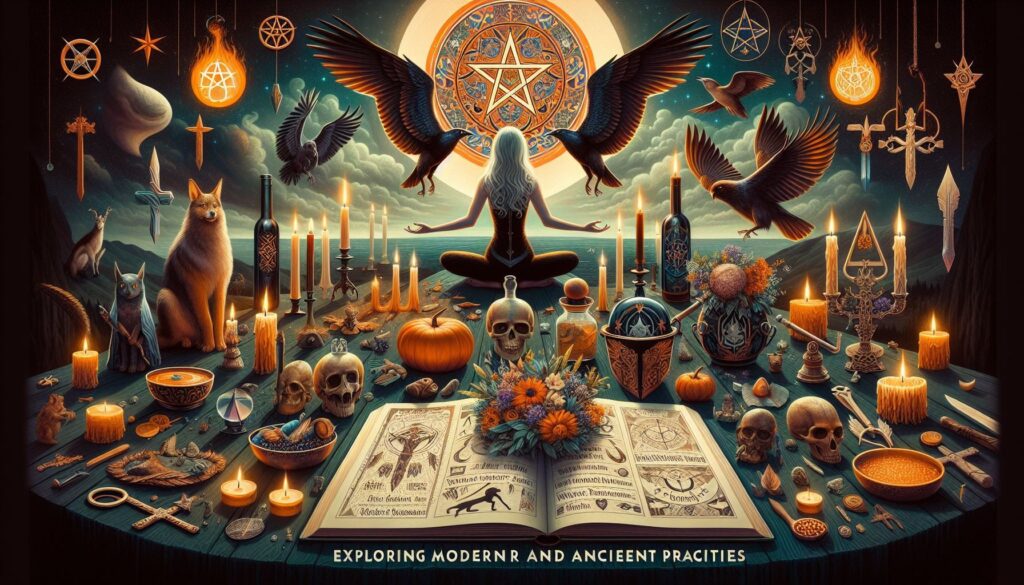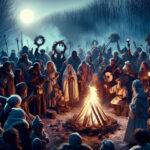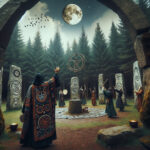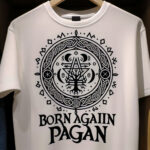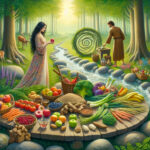Paganism encompasses a vast array of beliefs and practices, both ancient and modern. Traditionally, pagans have revered the natural world, deities from various pantheons, and celebrated the cycles of life and seasons. Ancient pagans of the fourth century within the Roman Empire practiced rituals and ceremonies that honored the earth, the sun, and the moon, recognizing their significance in daily life.
In contemporary times, paganism continues to thrive, evolving to include a broader spectrum of beliefs and rituals. Modern pagans may draw inspiration from ancient traditions, creating a diverse religious path that respects the interconnectedness of all things. The worship practices vary widely, including solo and group rituals, meditation, and the celebration of seasonal festivals, reflecting the rich tapestry of pagan spirituality.
Unveiling the Essence of Pagan Worship
Pagan worship is characterized by its diversity and depth, focusing on the veneration of gods and goddesses, the sanctity of nature, and the observance of seasonal festivals. Pagans find spiritual significance in various places of worship, from natural landscapes to consecrated temples and altars. Central to pagan rituals are the celebrations that align with the Earth’s cycles, such as solstices and equinoxes, allowing practitioners to connect deeply with the rhythms of the natural world.
The Diverse Deities and Spirits Celebrated by Pagans
Within pagan traditions, there is a rich diversity of deities and spirits that are venerated. These range from ancient gods and goddesses of specific cultures to more universal archetypes and elemental forces. Pagan practices often include rituals and ceremonies to honor these beings, especially during significant times like the winter solstice. This celebration marks the rebirth of the sun and is a testament to the deep connection pagans have with the cycles of nature and the divine.
Nature and the Elements: A Central Focus in Pagan Rituals
In pagan traditions, the natural world and its elements hold deep spiritual significance. Pagan practices often involve rituals that honor the earth, air, fire, and water, recognizing their essential roles in sustaining life. Celebrations like the winter solstice highlight this reverence, as pagans gather to welcome the return of the light during the darkest time of the year. Through such observances, pagans express gratitude and respect for the natural world, seeking harmony with its cycles and forces.
Tracing the Roots: The Evolution of Pagan Worship
The roots of pagan worship extend deep into history, with practices honoring gods and goddesses, sacred places of worship, and the celebration of seasonal festivals. These elements have been central to pagan spirituality since ancient times, reflecting humanity’s enduring connection to the natural world and the divine.
From Prehistoric Beginnings to the Bronze Age
The religions of the ancient world laid the foundation for modern pagan practices. From prehistoric animism to the complex deities of the Bronze Age, these early beliefs highlight humanity’s intrinsic desire to understand and honor the forces of nature.
The Transition from Nomadic Rituals to Structured Beliefs
As societies evolved from nomadic to settled ways of life, so too did their spiritual practices. This transition marked the beginning of more structured beliefs, with rituals and gods that reflected the complexities of agricultural and urban life. This period set the stage for the rich tapestry of pagan worship that would continue to evolve throughout history.
The Renaissance and Romanticism: Reviving Ancient Pagan Practices
In the fourth century, as the Roman Empire practiced Christianity, pagan traditions faced suppression. However, the Renaissance and Romanticism periods witnessed a revival of interest in these ancient practices. Scholars and artists of these eras drew inspiration from classical antiquity, sparking a renewed fascination with pagan mythology and spirituality.
The Influence of Classical Antiquity on Modern Paganism
The United States and Europe saw a resurgence of interest in pre-Christian religions and traditions during the 19th and 20th centuries. This revival, influenced by classical antiquity, including Greece and Rome, as well as the legends of King Arthur, reintroduced polytheistic religions, pre-Christian traditions, and practices into Western and Eastern Europe. This movement laid the groundwork for the contemporary pagan renaissance, bridging ancient wisdom with modern spiritual exploration.
Pagan Worship in the Contemporary World
The Pagan Federation, established in the late 20th century, symbolizes the organized aspect of modern paganism, advocating for the rights and understanding of pagans worldwide. This organization reflects the growing acceptance and practice of pagan traditions in today’s society.
The 1960s: Paganism’s Leap into Mainstream Culture
The 1960s marked a significant period when paganism and its reverence for the natural world as sacred began to enter mainstream culture. Influential figures and movements, notably from the University of California, emphasized the importance of celebrating the interconnectedness of life, drawing inspiration from ancient cultures and pagans. This era significantly influenced public perceptions of paganism, highlighting its focus on harmony with nature and ancient wisdom.
The Role of Witchcraft and Theosophy in Shaping Modern Pagan Beliefs
The modern pagan movement has been significantly shaped by the veneration of nature, a core principle shared by witchcraft and theosophy. These traditions emphasize the sacredness of the natural world, encouraging practices that honor the earth and its cycles. This perspective has deeply influenced contemporary pagan beliefs, fostering a spiritual path centered on respect for and alignment with nature.
The Global Tapestry of Pagan Traditions
Paganism today is a global phenomenon, reflecting a diverse tapestry of traditions and beliefs. From the revival of ethnic religions to the integration of contemporary spiritual practices, paganism continues to evolve, offering a rich array of paths for those seeking connection with the natural world and the divine.
Experiencing Pagan Culture: From Ancient Sites to Modern Festivals
Pagan practices are celebrated around the world, from ancient sacred sites to modern festivals. These gatherings serve as vibrant expressions of pagan spirituality, where participants can connect with the traditions and folk religion of their ancestors. Through rituals, music, and community, pagans continue to honor the cycles of nature and the legacy of the ancient world.
The Re-emergence of Ethnic Religions and Their Impact on Paganism
The re-emergence of ethnic religions has played a significant role in shaping modern paganism, enriching the spiritual landscape with diverse traditions and practices. This resurgence has fostered a deeper appreciation for the roots of pagan beliefs, encouraging a broader understanding and acceptance of various paths to the divine.
Understanding Pagan Beliefs and Practices
Paganism encompasses a variety of religious traditions, each with its own unique set of beliefs and practices. Rather than worshiping a single true god, pagans often revere a pantheon of deities, each embodying different aspects of the natural and spiritual world. Central to pagan worship is a profound respect for nature, seeing the divine manifest in all aspects of the natural world, from the changing seasons to the cycles of life and death.
Key Terms and Concepts in Pagan Worship
Key terms in pagan worship include “polytheism,” the belief in multiple deities, and “animism,” the belief that natural objects, places, and creatures possess a spiritual essence. Another important concept is “pantheism,” the belief that the divine pervades everything in the universe. Understanding these terms is crucial for grasping the complex, interconnected nature of pagan beliefs, which emphasize the unity of the spiritual and physical worlds.
Ethnocentrism and Perception: Navigating Misunderstandings of Paganism
Ethnocentrism, or evaluating other cultures based on one’s own cultural standards, often leads to misunderstandings of paganism. Many people, influenced by their own religious traditions, mistakenly view paganism through the lens of monotheism, interpreting the worship of multiple deities as the worship of false gods. This misunderstanding overlooks the rich spiritual and moral framework of pagan religions, which celebrate the diversity of the natural and spiritual world.
The Future of Pagan Worship: Trends and Predictions
As contemporary society becomes more pluralistic, paganism is experiencing a resurgence. This revival is partly due to a growing disillusionment with the dogmatic nature of monotheistic religions and a yearning for a more personal, nature-centric spiritual experience. Predictions for the future of pagan worship suggest a continued rise in popularity, driven by its adaptability and the increasing societal value placed on environmental stewardship and personal spiritual freedom.
The Rising Popularity of Paganism and Its Implications for Global Culture
The rising popularity of paganism reflects a broader shift towards spiritual pluralism and ecological consciousness in global culture. As more people identify as pagans, there is potential for greater acceptance and understanding of this ancient religious tradition. This trend could lead to a more inclusive and tolerant society, where diverse spiritual practices are respected and celebrated, enriching the global tapestry of religious traditions.
Technology and Social Media: New Frontiers for Pagan Communities
Technology and social media are playing a pivotal role in the growth of pagan communities. These platforms offer pagans the opportunity to connect, share resources, and organize events, regardless of geographical barriers. Online forums, social media groups, and virtual rituals have made paganism more accessible than ever, enabling a global community of practitioners to flourish and expand, fostering a sense of unity and shared purpose among pagans worldwide.
A Journey Through the Rich World of Paganism
The world of paganism is vast and varied, offering a rich tapestry of beliefs, deities, and practices that span cultures and continents. From ancient religious traditions to contemporary expressions of pagan worship, this spiritual path invites individuals to explore a deep connection with the natural world, the divine, and the community. It’s a journey that encourages personal growth, respect for diversity, and a rediscovery of ancient wisdom that speaks to the challenges of the modern world.
Conclusion: Embracing Diversity and Rediscovering Ancient Wisdom in Pagan Worship
In conclusion, the journey through paganism is one of embracing diversity and rediscovering the ancient wisdom embedded in the religions of Europe and beyond. As contemporary paganism draws from the spiritual beings and practices of the ancient world, it offers a counterpoint to the dominant narratives of monotheistic religions like Christianity, which emerged in the 1st century CE. This resurgence, particularly noticeable in the United Kingdom and other parts of the world, signifies a longing for a connection with the spiritual and natural realms, challenging the perception of ancient deities as false gods. Through this revival, paganism is re-establishing itself as a vital component of the global religious landscape, promising a future where the rich traditions of the past inform the spiritual practices of the present.

